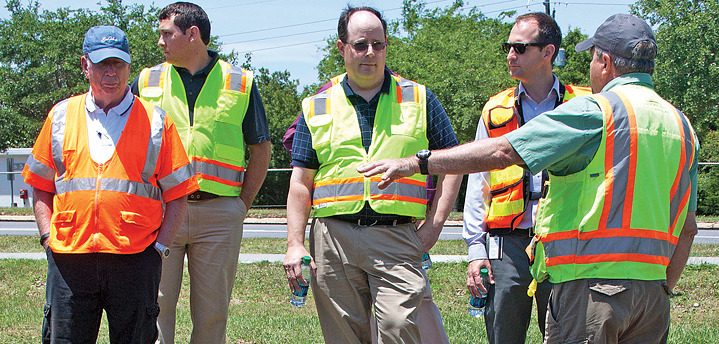Around 45 state and local officials and civil engineers gathered in Wrightsville Beach to see firsthand a pioneer concept: using runoff reduction techniques to break the direct relationship between rainfall and runoff into local waters — and subsequent swimming and shellfishing advisories.
The North Carolina Coastal Federation (NCCF) hosted the May 28 program, which included presentations and a tour of the project sites. NCCF teamed up in 2014 with the town of Wrightsville Beach, the University of North Carolina Wilmington and several other organizations to engineer and complete the stormwater best management practices (BMPs) using grant money from the National Estuarine Research Reserve.
The BMPs are simple and subtle. Ground was graded to funnel water into rain gardens or infiltration chambers, both of which allow the polluted runoff to seep slowly into the earth rather than washing directly through outfall pipes into local waters.
Wrightsville Beach was one of the first communities in the state to explore new ways of managing stormwater runoff, N.C. Department of Environment and Natural Resources stormwater staff engineer Mike Randall said, because of water quality issues in Banks Channel, Hewlett’s Creek and Bradley Creek. The effort focuses on simple, low-impact methods of diverting stormwater away from drains and outfall pipes, he said.
By comparing recent measurements of runoff and bacteria levels in local waters to baseline numbers taken in 2014, UNCW’s Dr. Mike Mallin obtained evidence of the BMPs’ effectiveness, which he presented to the officials and engineers.
One graph showed the relationship between rainfall amounts and stormwater runoff from an outfall pipe into Banks Channel before and after the pipe was retrofitted with a perforated section for water to seep through.
Before the retrofit, there was a direct relationship between runoff and rainfall, he said. After the retrofit, almost no runoff ever reached Banks Channel from the pipe, even during a recent storm that dumped seven inches of rain on the island.
Diverting stormwater into the ground serves a second — but equally important — purpose, Randall said. Forcing stormwater to infiltrate deep into the earth recharges the aquifer from which well systems pull drinking water, he said, which reduces saltwater intrusions, a common problem for communities close to the coast.
For that reason, he said, the town’s stormwater reduction techniques are still valuable for communities that don’t have to protect local waters for swimming or fishing as Wrightsville Beach does.
“I’ve been encouraging other local governments . . . to look at how Wilmington and Wrightsville Beach have taken a scientific approach to managing stormwater in a very cost-effective way,” Randall said. “Drinking water is going to get expensive if we don’t have it [in the aquifer]. … In the past, this wasn’t a problem, because you’ve got plenty of infiltration, but as you start to pave over everything you’re going to lose that infiltration.”
The BMPs would be even more cost-effective if, rather than being retrofitted, they were designed into a development project from the outset, one of the attendees, New Hanover County engineer Jim Iannucci, said. After the BMP site tour, he said he could envision using several of the techniques in a number of the county’s future construction projects.
Specifically, he said, the county was considering installing rain gardens around the new Myrtle Grove Library branch and regrading the New Hanover County Government Center’s parking lot to improve drainage.
Cape Fear Community College construction project manager Tony Carter had a similar reason for attending, saying the school is in the midst of several building projects and he wants to keep abreast of the latest stormwater reduction practices.
Hunter Freeman, who designed Wrightsville’s new rain gardens, swales, berms, infiltration chambers and retrofitted pipes, emphasized the importance of adapting stormwater runoff reduction techniques as development and impervious surfaces continue to overtake natural areas.
“We were programmed for a long time to just get the water off of the land,” he told the engineers and officials Thursday. “But the driving focus here is to . . . take water from the roadway surface and get it to a grassy area . . . instead of having that water go into a catch basin immediately or into a pipe network.”
email [email protected]




